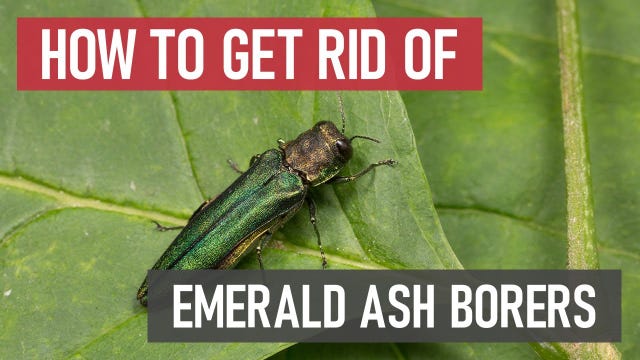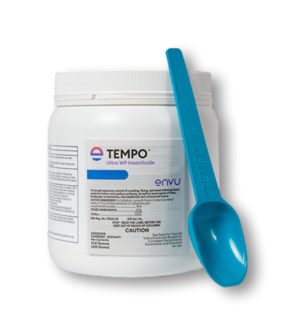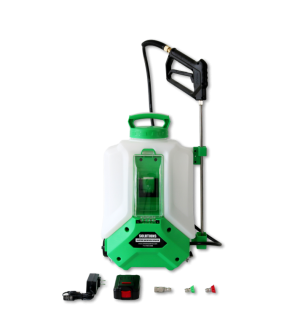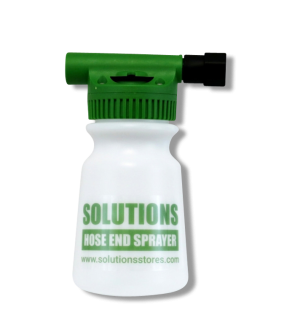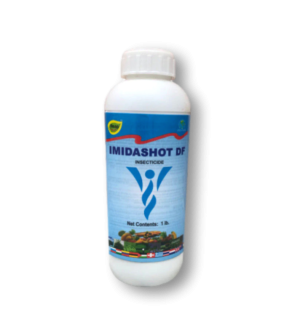Gain access to personalized product screening, the best pricing, rewards, and more!
Most Effective Products
Emerald Ash Borer Control: How To Get Rid of Emerald Ash Borer
This page is a general DIY guide for controlling emerald ash borer. Using the products and methods suggested, you will get control of emerald ash borers. Follow this DIY article and use the recommended products; we guarantee 100% control of emerald ash borers.
Emerald ash borers, commonly referred to by it's acronym EAB, are an invasive beetle species brought from Asia during the early 2000's. Since their accidental introduction, these tiny metallic green insects have rapidly spread, killing millions of ash trees and disrupting local ecosystems.
The real damage comes not from the adult beetles but from their larvae. After the adults lay eggs on ash tree bark, the larvae hatch and burrow under the bark, feeding on the tree’s inner bark and disrupting the flow of water and nutrients. This feeding creates galleries that girdle the tree from the inside, eventually killing it.
Losing these trees means losing these environmental and economic benefits, as well as facing the expense and labor of removing dead trees.
Because ash trees have no natural defenses against emerald ash borers, infestations often lead to widespread mortality in trees. The emerald ash borer might be small, but its impact is huge. By staying informed and proactive, you can help protect your ash trees and preserve the green spaces you cherish with the tips and products in this article.
Identification
Before you can proceed with a treatment program, you must be sure that your pest is indeed an emerald ash borer. Misidentification can lead you to use the wrong treatment products and waste time and money. Below are some characteristics of emerald ash borer to aid in identification:

- The emerald ash borer is a slender beetle that measures between between 3/8- and 1/2-inch long and 1/16-inch wide. They have a bright, iridescent emerald green color, often with coppery or golden tones, and their wing covers fit tightly over a purplish-red body that is visible only when the wings are open.
- Large and dark eyes, often appear to wrap around the sides of the head.
- In its larval stage, the emerald ash borer is creamy white, segmented, and flattened with a somewhat bell-shaped front.
Use the description and image above to determine whether the pest you encounter is an emerald ash borer. If you are unsure, contact our experts; we will help you identify the correct one.
Inspection
Once you have confirmed the infestation is emerald ash borer, you can move on to inspection. During this phase, you will locate the areas where emerald ash borer are infesting and observe the conditions allowing them to thrive. This information will help you determine where to apply pesticide applications.

Where to Inspect
Emerald ash borers attack several species of ash trees by burrowing under the bark and inner wood, feeding on the tree’s vascular system.
What to Look For
Adult beetles can be active from May to October. After laying eggs, larvae will hatch after two weeks and will feed for 1 to 2 years.
Signs of emerald ash borer infestation include distinctive D-shaped exit holes on the bark where adult beetles emerge, as well as vertical splits or cracks caused by larval feeding beneath the surface.
Under the bark, larvae create S-shaped tunnels that disrupt the tree’s ability to transport water and nutrients.
Infested ash trees often show thinning or dying canopies, with leaves turning yellow, brown, or sparse. Increased woodpecker activity is common, as these birds feed on the larvae hiding under the bark.
Trees may also produce small sprouts called epicormic shoots on the trunk or branches as a stress response. Over time, these symptoms indicate a decline in tree health that usually leads to the tree’s death if the infestation is not managed.
Treatment
Before you begin any type of pesticide application, you will need to wear the appropriate personal protective equipment (PPE) when mixing or spraying.
So, how do you actually get rid of emerald ash borers? Some of the best insecticides contain imidacloprid, dinotefuran, emamectin benzoate, and azadirachtin to help keep your ash trees safe.
If infestation is severe, removing and destroying infected ash trees can help prevent the spread.
Step 1: Apply Imidacloprid 2F Insecticide
 To manage emerald ash borers, apply a systemic insecticide that is absorbed by the tree and targets the pest as it feeds.
To manage emerald ash borers, apply a systemic insecticide that is absorbed by the tree and targets the pest as it feeds.
Imidacloprid 2F Insecticide is a powerful, long-lasting systemic solution designed to protect trees, shrubs, and turf from destructive insect pests like emerald ash borers. With its fast-acting, soil-applied formula, this professional-grade insecticide delivers targeted control by moving through the plant’s vascular system to eliminate pests from the inside out.
This product will need to be mixed with water in a hose-end sprayer or backpack sprayer.
Determine the diameter of your tree trunk at diameter breast height (DBH). To do this, begin by measuring 4.5 feet above the ground level. Hold the ruler or tape measurer against the tree, then wrap it around the middle of the tree at the DBH, and record your findings.
For soil drench applications of Imidacloprid 2F Insecticide to control pests such as emerald ash borer, apply 0.1 to 0.4 fluid ounces of product per inch of trunk diameter at breast height (DBH).
For trees up to 15 inches in diameter at breast height, DBH, apply 0.1 to 0.2 fluid ounces of product in at least 10 gallons of water. For larger trees, apply 0.3 to 0.4 fluid ounces of product.
Apply it uniformly around the base of the tree, directing the solution to the root zone. Be sure to remove any plastic or barriers that could prevent the solution from soaking into the soil.
Apply in early spring for optimal uptake and pest control.
When making soil applications to plants with woody stems, systemic activity will be delayed until the active ingredient is taken up throughout the plant. In some cases, this translocation delay could take 60 days or longer.
Do not apply this product, by any application method, to linden, basswood, or other Tilia species.
Do not allow people or pets to enter treated areas until the sprays have dried.
Keep in mind that after emerald ash borers have been controlled, trees with existing damage and stress may never fully recover.
Prevention
After successfully eliminating emerald ash borers from your property, you will want to ensure these pests do not return. Here are some preventative measures we suggest following to keep emerald ash borer away.

- Removing and properly disposing of heavily infested or dead ash trees prevents the emerald ash borer beetles from completing their life cycle and spreading to nearby healthy trees.
- Store firewood away from healthy ash trees to reduce the risk of attracting these pests. Keep the woodpile elevated off the ground on a rack or platform to improve air circulation and reduce moisture, which discourages emerald ash borer activity. Cover the firewood with a breathable tarp to protect it from rain and adult pests. It’s also best to use or burn firewood within one year of cutting to minimize the chance that the larvae or adults develop and spread.
- Keep ash trees healthy to discourage emerald ash borers by watering during dry spells and avoiding damage to the trunk and roots during mowing. Proper fertilization and good soil care also help trees stay strong and less attractive to pests. By keeping ash trees vigorous and stress-free, you reduce their vulnerability to emerald ash borer attacks.
- One of the most effective strategies is to apply a systemic insecticide such as Imidacloprid 2F Insecticide before any visible signs of damage occur, ideally in early spring when trees can absorb the product effectively. Preventive treatments are most successful on healthy or lightly infested trees, as heavily damaged ones often cannot be saved. A soil drench application can last up to 1 year, but foliar and turf sites will require a repeat application when at least 5 days have passed from the first treatment. Do not exceed a total of 1.6 pints of product per acre per year.
Key Takeaways
What are Emerald Ash Borers?
- Emerald ash borers are small, metallic green beetles native to Asia that attack and kill ash trees. Their larvae burrow under the bark, disrupting the tree’s ability to transport water and nutrients, which eventually leads to the tree’s death.
How To Get Rid of Emerald Ash Borers
- To get rid of emerald ash borers, infested ash trees should be removed promptly and destroyed to prevent the beetles from spreading. We also recommend using Imidacloprid 2F Insecticide.
Preventing Emerald Ash Borer Reinfestation
- Removing heavily infested or dead ash trees and properly storing firewood away from healthy trees helps prevent the emerald ash borer spread, while maintaining tree health through watering, careful mowing, and fertilization reduces vulnerability. Applying a systemic insecticide like Imidacloprid 2F in early spring before damage appears offers effective prevention, with soil drench treatments lasting up to a year and repeat foliar or turf applications required as directed.






